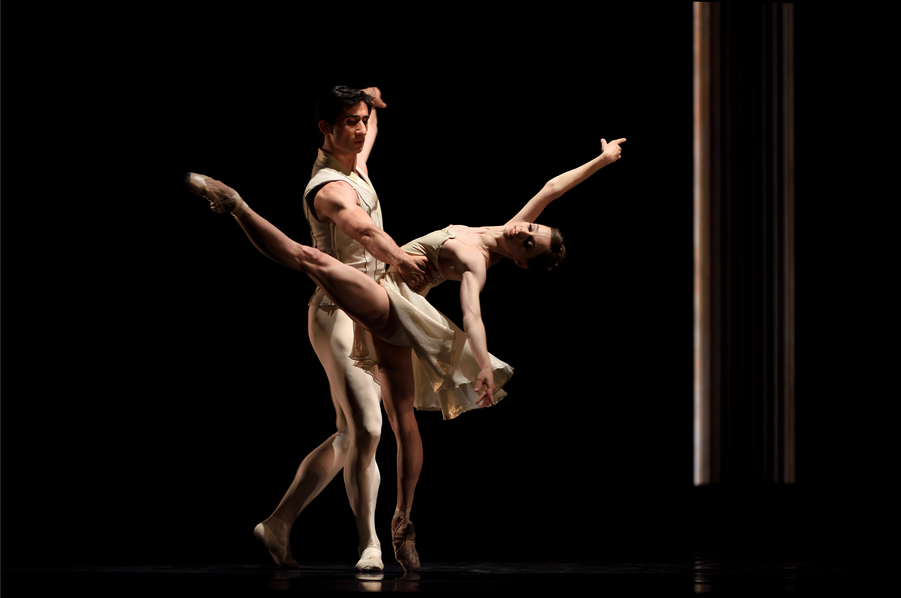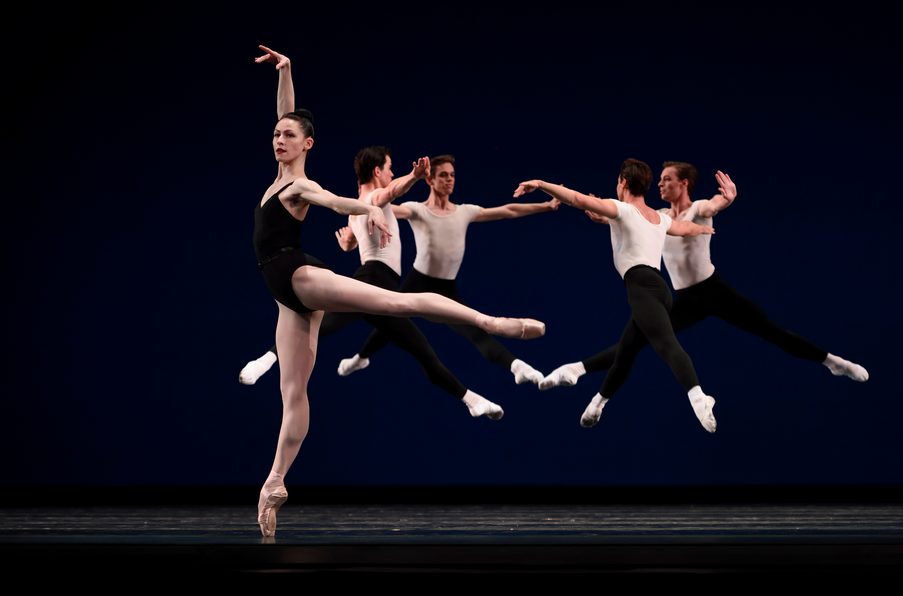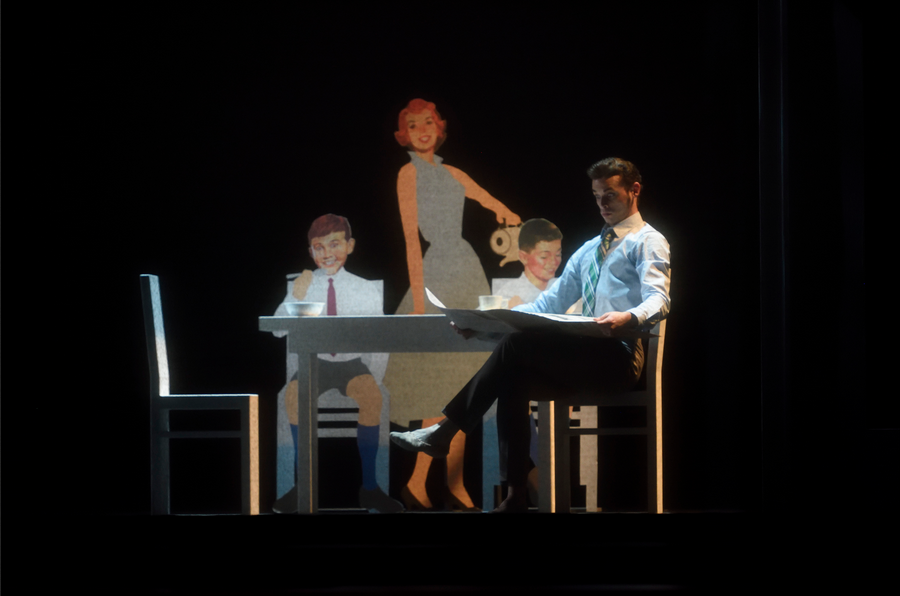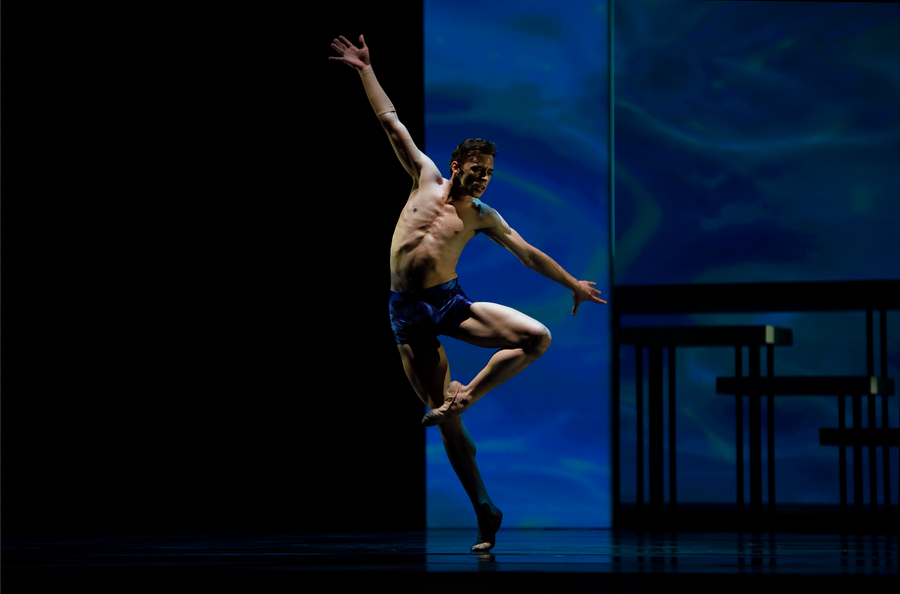Two weekends ago the San Francisco Ballet’s performed Caprice and The Four Temperaments. I witnessed these two ballets on a Friday evening and found them to be an accurate demonstration of the range of emotions ballet has the potential to express. The two colors presented by these performances—light and dark—mixed into a yin and yang harmony that preceded the headline performance, the world premiere of Swimmer, choreographed by Yuri Possokhov. In conjunction, these three ballets created a spectacle full of contrast and varied form.
Caprice, Helgi Tomasson’s newest work for the San Francisco Ballet Company, featured an assortment of very elegant and swift movements danced by the classic male and female coupling. The male and female dancers were clad in nude costumes and met one another in a circular dance that proceeded in cycles mid-stage—resembling a rotary waltz. One ballerina, wearing a loose, white, costume was showcased in the center of the waltz-like-dance with grand and elegant lifts that highlighted the immense back flexibility of the ballerina; her male counterpart picked her up from behind and she seamlessly folded into a u-shape from her mid-back, and withstood multiple aerial rotations.

Maria Kochetkova and Davit Karapetyan in Tomasson’s Caprice
Caprice takes on a an innovative use of the silky tips of the ballerina’s pointe shoes as she is dragged across the stage on her pointed toes and strong, straddled legs. It appears as if she is in flight or skating on ice as three male dancers take turns gliding across stage. The form is like the fluid motion of oil gliding across the surface of water with all the added symmetry and simplicity of a Rorshach diagram.
The Four Temperaments is visually as simple with a different set of moves that are enunciated from each joint of the body, rather than swiftly and smoothly like the ribbon mimicking whips of the dancers in Caprice. The Four Temperaments contrasts the costuming of Caprice as well, with the pink tights and black leotards on the female and male dancers, as opposed to nude costuming. Despite the more enunciated articulation of movement in The Four Temperaments, there’s a unity that resembles the visual symmetry of Caprice. The symmetrical leaps, arm placement, and timed steps calls the audience to find a new way to acknowledge individual dancers, whereas this individuality may have appeared more obviously in Caprice, which utilized different colored costumes and aggrandized leaps and lifts to showcase central dancers through the narrative of form of choreography.

Sofiane Sylve in Balanchine’s The Four Temperaments
At last, the third part of the ballet began: the world premiere of Swimmer. A trill of jazz music and xylophones played and a clear screen lowered above downstage with the curtains. The curtain obscured the vision of the audience until lights illuminated the background and foreground of the stage. A simple set design of an outlined house with a bedroom, bathroom, kitchen, and front door step was on view. The opening movement looked and sounded like the dream of middle class America during the 1950’s. The main dancer, this time a male, rose from bed with the start of the music and with flexed—rather than pointed feet—charged into the shower before he grabbed a quick breakfast with his cardboard cutout wife and kids and running out the door. Average Joe boards a bus with other middle-class folk and they teeter back and forth within the automobile as the projection on the screen turns into an underwater fantasy. Is this the imagination of the main character? Perhaps. If anything, it is a retreat from the literally heavy-footed pace of reality.

Taras Domitro in Possokhov’s Swimmer
The scenery changes; the frame of the house disappears as a white platform appears up stage, and down-stage several pairings of male and female dancers in brightly colored costumes partake in partnered dances. The variety of dance inspiration in Swimmer is certainly eclectic and modern. As ballerinas swing dance and salsa with their male counterparts, they do so en pointe.
What’s interesting about the setting of these dances is the use of light displays and projections onto the foregrounded screen to demonstrate the aquatic environment of the dance. A few seconds of poolside water is reflected onto the screen before the main character changes into his costume: a boy-short length Speedo—average Joe has now become the swimmer.
The choreography of these dances is far more light and pointed than the flexed foot choreography within the first two movements. It embodies the typical anti-gravity movement of ballet that seems to defy the reality of weight and heaviness that afflicts the normal human in daily life.
The swimmer dances lightly and freely with multiple female mistresses before the setting changes once more. He appears to be on land, although he is still clad in his speedo. Waves of grain are projected on the screen as he runs—out of the light and watery environment he danced in before. Confused, he wanders about aimlessly until he comes across a group of boys partaking in land sports: they hold mitts, bats, rackets, and balls. The youths charge at the swimmer and he charges back, until finally, the youths put down their equipment and follow the swimmer as he teaches them to dance lightly and freely as he does. They end their encounter by lying down on their bellies looking off the stage into the distance, as if reminiscing about the future—or day dreaming of another world, like the world of the swimmer.
The mood of the scenery loses its color, and the music gets injected with percussion and bass as many male dancers in white clothing come out in an aggressive battle of dance. The movements are physically challenging, complex, and demanding of stamina. It appears to last forever, in comparison to the joyous dances of the swimmer with young and colorful women.
Following the swimmer’s encounter with land, this movement illustrates the internal conflict that being on firm ground poses for the swimmer; it elicits conflict between his sense of desire and responsibility.
The swimmer encounters the empty frame of his home once more, but the upbeat music and bright light of the first movement are no more. His cardboard wife and children are absent and he heavy-handedly bangs on the front door of his house, as if a stranger. He tumbles across the floor of his bedroom searching for something, or maybe even trying to confront how he no longer belongs in this world—reality.
The form of the dance in this empty house is very heavy and demonstrates the weight of the dancer and the effort it takes to launch oneself into the air, only to fall on the ground. It’s very moving to see the swimmer encounter and fight this sense of loneliness that speaks to the everyday experience of the modern American.

Taras Domitro in Possokhov’s Swimmer
It’s hard to say whether the resolution the swimmer meets at the end of the ballet is one of peace or sadness—it may be a combination of both.
Rough, dark seas are projected on the foregrounded screen and a white figure is seen drowning and floating, before he sinks to the bottom of the ocean. The image fades, as the swimmer is then shown suspended in the air, in an inverted position—as if he is now, finally swimming. At this point, all of his attempts to defy gravity and reality have now paid off—he is literally floating… but at what expense?
Swimmer is an incredibly moving ballet that effectively helps the audience understand and examine the trade off that comes about seeking one’s hopes and dreams. It follows the traditional ebb and flow of plot, and ultimately, illustrates the sacrifice and gravity that can often accompany dreams of levity.
The pairing of Caprice and The Four Temperaments before hand adequately prepares the audience to view the final display, Swimmer, with a taste of the variety of style that can take place in ballet; ultimately, the pairing states that ballet is not merely pastel colors and leaps. It is dynamic, it is intense, and it is still applicable to our daily lives.
